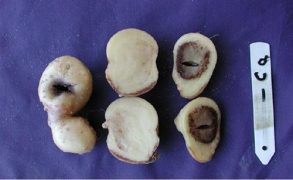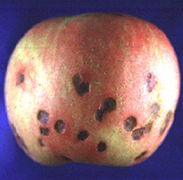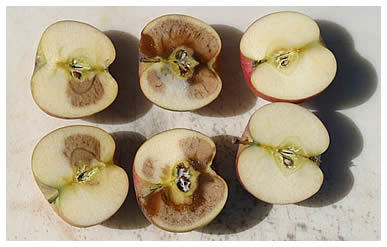In recent weeks, I have had one or two questions relating to apples and potatoes and the common denominator is “internal browning”.
You wouldn’t think that such a problem in two entirely different plants would have the same reason – or would you?
The problem has the same cause – calcium deficiency. Let’s start with the condition known as Bitter Pit in apples. Two of our most popular varieties, Cox’s Orange Pippin and Bramley Seedling, are susceptible to the condition. Symptoms are sometimes noted at harvest time when dark sunken spots appear on the skin, a first indication of the problem, but more often it will develop in storage, in the form of internal browning and that is referred to as Bitter Pit.
I could almost wander a little here by suggesting that it is a bit like Blossom End Rot which affects tomato fruits. In that case, it is caused by an interruption to the water supply, not necessarily a deficiency of calcium in the growing medium. In other words – irregular watering. Therein lies the link because Bitter Pit can be induced in trees growing in light soils in a dry summer! Still with me?
Experience shows that some crops grown in acid soils may be subject to a range of nutritional disorders. That is why we preach the need for rotation, regular additions of organic matters AND liming.
That train of thought becomes even more relevant when you think of planting perennial long-term crops like fruit trees. It is quite an investment, so it is important to get the conditions right before you start. This view is endorsed in the present scenario when you consider that Bitter Pit is quite likely to affect young trees.
This often happens when gardeners, anxious to get the young trees off to a flying start, are too liberal with the fertiliser. I’m now painting a dire picture where young trees are planted in light soils, many of which are acid, excess fertiliser (especially nitrogen) is applied in the early part of the growing season, the young trees are off like the clappers, we get dryish summer weather and, bingo, you have the exact conditions in which Bitter Pit will develop.
You have been warned.
Now then, we come to internal browning of potatoes and, in this case, it is even more like Blossom End Rot of tomato, perhaps because they are part of the same family. The fact is internal browning in the tubers is more likely to occur in potatoes growing in lighter, acid soils and subjected to periods of drought.
In both cases, the onus is on the grower to manage the growing conditions efficiently.
Here’s a thought …
Now into the darker nights, we are all glad of the street lights that guide us safely on our way from one place to another. A good thing or a bad thing? Depends whether you are human being or a tree.
In other words, what effect does continuous lighting have on deciduous trees lining many of our streets and, indeed, in gardens adjoining the floodlit streets and walkways?
Professional plant growers regularly manipulate day length to induce unseasonal growth in plants and the most common example is the so-called pot chrysanthemum.
A natural late summer/early autumn flowering plant, by manipulating the hours of darkness using blackout and the hours of light by using lights, they can produce these little beauties to order any day of the year.
Some people regard street lighting as a form of pollution but I’m not going down that road. However, it does need to be taken into consideration when choosing the type of lighting and the species of plant.
The stronger the influence of the light (high pressure sodium is the best example) the more likely it is to affect the annual growth rate of some trees as well as the flowering and hence the reproductive cycle, but that may not be of any relevance in this particular instance.
Most street lighting is not strong enough to affect photosynthesis, but younger trees, full of vigour, may carry on growing later into the autumn/early winter and fail to develop a dormancy pattern and that may cause them to suffer more winter damage.
Where did that come from, you might ask?
Quickly then – daughter-in-law has a sister living in Sydney, Australia. In Susanne’s garden is a wonderful magnolia. Foliage is being savaged by possums! The tree is de-foliated. Time for action – all-night lighting is the answer.
For how long? What intensity? Expensive but what effect will it have on the tree. Will it survive? Let’s ask sister Verona’s pa-in-law in Oldmeldrum.
